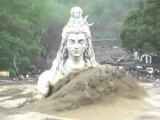The events in Uttarakhand after June 16, 2013 are fresh in the minds of everyone in India. On June 17, 2013 a cloudburst was reported in Kedarnath and Badrinath region of Uttarakhand . This was followed by heavy rains which caused landslides and flashfloods.
The impact of the cloudburst, heavy torrential rainfall and resulting flash floods in the region is difficult to imagine. The loss of life may run into thousands and it is unlikely that there will be ever an accurate figure.
Most of the affected people were on a pilgrimage to Char Dham, Badrinath, Kedarnath being the fourth and the last. The loss of property and infrastructure is colossal. Most roads in the area, almost all the bridges and a large number of buildings and houses have collapsed. Townships were washed away. The entire road transport system in Rudraprayag, Chamoli and beyond up to Kedarnath and Badrinath has collapsed.
Char Dham (the four abodes of God) are the names of four pilgrimage spots in India that are widely revered by most of the Hindus. They are Badrinath, Dwarka,Jagannath Puri, and Rameshwaram. However, over the years, the term “Char Dham” has come to mean pilgrimages in the Garhwal Himalayas (part of Uttarakhand). It is the most renowned and holy pilgrimage in India, which includes visiting the four shrines: Yamunotri, Gangotri, Kedarnath and lastly the Badrinath Dham.
Who is responsible for this calamity? Is it man made or an act of God? Human activity and resulting climate change may be partly responsible for it, but by and large it appears to be an act of God and we should blame the freak weather for it.
Nobody could have anticipated it or anybody could have prevented it.
In the words of Shri. M. Shashidhar Reddy, Vice chairman, The National Disaster Management Authority (NDMA),” Only precise forecast of rain would have helped. Weather wizards working at the India Meteorological Department (IMD) need to pinpoint where and how much it is going to rain. They need to develop a more precise observational and forecasting capability at least for sensitive spots like Uttrakhand.”
Typically, southwest monsoon (SWM) hits Kerala in the last week of May or early June. Since 2005, the onset date varied between May 23 (2009) and June 7 (2005). This year it was on June 3.
When the SWM reaches India, it splits into two parts, Arabian Sea Branch and Bay of Bengal Branch. The Arabian Sea Branch first hits the Western Ghats along the coastal state of Kerala. It then moves northwards causing heavy showers in Kerala, Karnataka, Goa and. Maharashtra in that order and then spills into interior Maharashtra, Andhra Pradesh, Madhya Pradesh and the like, which do not receive as much rain as the coastal areas.
Bay of Bengal branch of SWM is deflected towards west by the southern ridges of the Himalayas and North-South hills of Assam. The two branches usually merge over northern India by the second week of July. When moisture laden clouds advance towards west they go on shedding their moisture in the form of rain. In Kolkata the amount of rainfall is 105 cms. In Delhi, it is only 59 cms. Further it goes on decreasing and in Ambala it is less than 40 cms.
The June 2013 monsoon rains in Uttarakhand were highly unusual, as the monsoon reached the region two weeks earlier than normal. After arriving in Kerala near the normal date, SWM advanced across India in an unusually rapid fashion, arriving in Pakistan along the western border of India on June 16, a full month earlier than normal.
This was the fastest progress of the monsoon on record. The previous record for fastest monsoon progress was in 1961, when all of India was under monsoon by June 21.Heavy rains have started once again in Uttrakhand beginning on Monday,
June 24, 2013 creating further problems in rescue operations.
What is a cloudburst? A cloudburst is an extreme form of rainfall, sometimes mixed with hail and thunder, which normally lasts for a few minutes to a couple of hours, but is capable of creating flood conditions which are called as flashfloods. In some cloudbursts, up to almost 13 centimeters of rain can fall in an hour,
often in the form of extremely large droplets.
Cloudbursts descend from very high clouds, sometimes with tops above 15 kilometers. During a cloudburst, more than 2 cm of rain may fall in a few minutes and the results are generally disastrous.
A flash flood is a rapid flooding of low-lying areas – rivers and streams. It is caused by heavy rain associated with a cloud burst, thunderstorm, hurricane, or tropical storm. Flash floods can also occur after the collapse of an ice dam, or a human structure, such as a dam.
Flash floods occur when the ground becomes saturated with water that has fallen too quickly to be absorbed as in a cloudburst. The runoff collects in low-lying areas and rapidly flows downhill.
Cloudbursts often occur in Uttrakhand during the monsoon. Some instances are given below. On July, 1970 a cloudburst and resulting flashflood in the upper catchment area of Alaknanda River in Uttarakhand led to a 15 metre rise in water level. The entire river basin, from Hanumanchatti near Badrinath to Haridwar
in the plains was affected. An entire village was swept away.
On July 6th 2004, At least 17 people were killed and 28 injured when three vehicles were swept into Alaknanda River by heavy landslides triggered by a cloudburst that left nearly 5,000 pilgrims stranded near Badrinath shrine area in Chamoli district of Uttaranchal Pradesh.
Again on August 7th 2009, 38 people were killed in a landslide resulting from a cloudburst in Nachni area near Munshiyari in Pithoragatrh district of Uttarakhand.
In a research paper, Dr B. N. Goswami, from the Indian Institute of Tropical Meteorology, based at Pune, said “There are significant rising trends in the frequency and the magnitude of extreme rain events and a significant decreasing trend in the frequency of moderate events over India during the monsoon seasons from 1951 to 2000.”
“The seasonal mean rainfall does not show any significant change, because the contribution from increasing heavy events is offset by decreasing moderate events. A substantial increase in hazards related to heavy rain is expected in India in the future.” He further added.
– PTI Feature
































